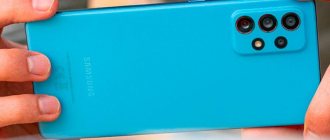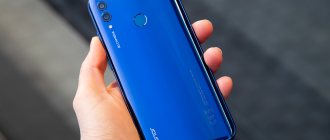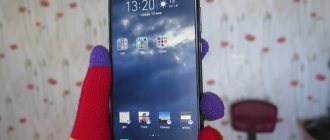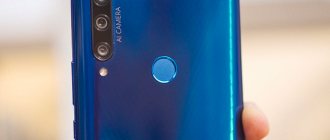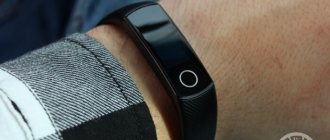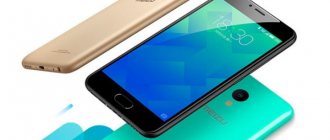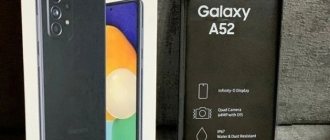Main characteristics of Honor 8X
| Screen | LTPS, 6.5″, 1080×2340 |
| Iron | HiSilicon Kirin 710 2.2 GHz, 4 x Cortex-A73, 4 x Cortex-A53, Mali-G51 |
| Memory | RAM 4 GB, ROM 64/128 GB, Micro-SD up to 400 GB, separate slot |
| Mobile Internet | LTE cat.4 150/50 Mbit/s HSDPA, HSUPA EDGE |
| Mobile networks | LTE Bands 1,3,7,8,20 UMTS 900, 2100 GSM 850, 900, 1800, 1900 |
| Battery | Li-Ion, 3750 mAh, 5V/2A |
| Dimensions | 160.4 x 76.6 x 7.8 mm |
| Weight | 175 g |
| Camera | dual 20 MP f/1.8 + 2 MP front: 16 MP, f/2.0 |
| Navigation | GPS, GLONASS, BeiDou |
| OS | Android 8.1 Oreo, EMUI 8.2 |
| Sensors | Accelerometer, Gyroscope, Compass, Zoom, Light, Fingerprint Scanner, NFC |
| SIM | 2 x Nano-SIM |
| Price | From 15500₽ |
The essence of the Honor 8X smartphone is all in the title of this review, in a few words. Large - six and a half inches of screen. And not too expensive - cheaper than twenty thousand rubles at the start of sales.
Is Eight X any good? Yes, good. I will spit a little venom towards the camera. Well, a number of little things that we’ll talk about during the review. Nothing significant, but it doesn't hurt to know about them.
But in general, yes, very good. Well, let's talk about everything in order.
Price
In Russia, two varieties of Honor 8X are officially sold - 4+64 GB and 4+128 GB. For the younger one in serious stores they want 17,990 rubles, the older one is two thousand more expensive - accordingly, 19,990 rubles.
Just the other day, the 8X suddenly appeared in a lot of small stores. The prices there are more reasonable - from about 15,500 rubles for the younger version.
If you buy on Aliexpress, you can save even more. Four thousand. True, the “Chinese” will not have NFC and the correct LTE bands (seventh and twentieth). And if you can still live without NFC, then buying a smartphone, essentially, without LTE, is somehow a little offensive.
By the way, I asked around small shops. Everyone swears in unison that they are selling the right model, with NFC and our native frequencies.
Display
The new Honor 8X is equipped with a 6.5-inch IPS display with FHD+ resolution (1080 × 2340 px, pixel density 396 ppi) and an aspect ratio of 19.5: 9. The screen occupies approximately 84.4% of the entire front panel.
The more massive model received a 7.12 inch IPS matrix. Its resolution is also FHD + (1080 × 2244, pixel density per inch - 350 ppi), but the aspect ratio is 18.7: 9. The matrix here occupies approximately the same area - 83.4% of the front side of the mobile phone.
The first tests show that for such a price the quality of the screens here is excellent. There are no complaints about the brightness adjustment range, viewing angles and color rendition. It’s nice that budget and mid-budget devices have already reached a high level in these parameters and offer decent matrices.
The settings have different color presets and color adjustment options. A night mode is available to reduce eye strain in low light conditions.
Appearance
| Weight | 175 g |
| Size | 160.4 x 76.6 x 7.8 mm |
| Protection | No |
Three colors. Black, blue, red. It seems that a light purple version also exists in nature, but it is not officially imported into our country.
I had a blue copy for testing. Handsome, definitely. If you look from the back, it's understandable. The front of smartphones these days are all the same - they all have narrow frames and some kind of stupid cutout.
Dark blue iridescent gloss. Moreover, it is heterogeneous. About a quarter of the back along the long left side is visually separated from the rest. As a result, “in landscape orientation” the smartphone looks sharply like a point-and-shoot camera. Exquisitely done.
The back surface is glass. Apparently, it is very durable - it does not scratch (at least for me). But it quickly becomes covered with fingerprints, alas.
Like the vast majority of modern smartphones, the 8X is quite slippery. So - straight into the case. Although it’s a pity to hide beauty, what can you do?
The cameras are sticking out. A little, but they stick out. So, if without a case, then on a smooth table the smartphone does not lie very flat, it sways a little.
There is an LED, but it is very dim. In the dark it is visible normally, but during the day you can easily miss its blinking.
Boring details
Above the screen there is a hole about three centimeters wide. It comfortably houses a speaker, light-proximity sensors, a front camera, and an LED.
The screen is blank.
Rear Dual camera with flash - in the upper left corner. The fingerprint scanner is in the traditional place.
Top edge. Lone microphone for noise reduction.
Bottom edge. Audio output 3.5 mm, main microphone, Micro-USB, loud speaker.
Right side. Volume rocker, power-lock button.
Left side. Card tray.
Communication with the outside world
| 4G | LTE Bands 1,3,7,8,20 LTE cat.4 150/50 Mbps |
| 3G | UMTS 900, 2100 HSDPA, HSUPA |
| WiFi | a/b/g/n/ac, 2.4 + 5 GHz |
| Bluetooth | v4.2, A2DP |
| USB modes | MTP |
| USB-OTG | + |
| MHL | — |
| NFC | + |
That USB is micro is, of course, not encouraging. Otherwise there are no questions. Dual-band Wi-Fi, NFC enabled. Everything is fine with the connection.
Screen
| Matrix | LTPS |
| Diagonal | 6.5″ |
| Permission | 1080×2340 |
| PPI | 397 |
| Multi-touch | 10 |
| Max white brightness | 335 cd/m2 |
| Min white brightness | 1.6 cd/m2 |
| Contrast | 650:1 |
| Color temp. | 7100-8400K |
| Gloves | No |
Huge high resolution screen. Stretched according to modern fashion. The frames on all sides are reasonably narrow - i.e. narrow, but without fanaticism.
Neckline Well, yes. Where would we be without him? Quite big.
The brightness is more or less sufficient. For the sun I would like just a little more.
The screen has a standard factory film. Good, slippery, even with an oleophobic coating (albeit not of the highest quality).
Interestingly, judging by user reviews, the screen itself also has an oleophobic coating. But for some reason Huawei support doesn’t know about this.
Battery
The battery capacity is quite large - 3750 mAh. Which is quite expected for a device with such a large screen.
Battery tests gave 182% of my conditional standard. The result is not a masterpiece, but good. With my lifestyle, a smartphone easily lasted me two days.
Weaknesses (relatively weak) are traditional - heavy games and working as a navigator.
| Full discharge time | Discharge in an hour | |
| Video | 13:30 | 7.4% |
| Video HD | 12:40 | 7.9% |
| Easy game | 9:20 | 10.7% |
| Hard game | 6:20 | 15.6% |
| Telephone | 29:00 | 3.5% |
| Music | 78:10 | 1.3% |
| GPS on 3G window | 7:20 | 13.5% |
| GPS on Wi-Fi window | 7:40 | 13.1% |
| White screen | 14:30 | 6.9% |
| White screen 0% | 8:20 | 12.1% |
| Internet 3G | 11:10 | 9.0% |
| Internet Wi-Fi | 12:20 | 8.1% |
| Slow torrent Wi-Fi | 55:40 | 1.8% |
⇡#Autonomous work
Honor 8X has a non-removable battery with a capacity of 3750 mAh. By the standards of large smartphones, the figure is slightly higher than the “hospital average.” In practice, this gives a reliable full day of battery life from very early morning until very late evening. If you lower the brightness below 50% and forcefully limit the appetites of particularly voracious applications in the settings, then you can probably squeeze even more out of this battery. In our traditional HD video playback test with maximum brightness, the device lasted exactly 8 hours.
There is a lot of debate on the Internet about whether the gadget supports fast charging or not. Formally, it is not stated anywhere, but in fact, the Honor 8X charges from 0 to 60% in an hour using the native adapter included in the package, and the indicator travels from 0 to 90% in 95 minutes. Not a record, but fast enough. The remaining 10% is gained significantly more slowly - in 45 additional minutes, so it will take you 130 minutes to fully charge your smartphone. Just remember that instead of the seemingly almost ubiquitous USB Type-C, Honor 8X is for some reason equipped with an archaic microUSB connector.
Huawei Honor 8X as a photo and video camera
| Rear: | 20 MP f/1.8 + 2 MP |
| Frontal: | 16 MP f/2.0 |
They didn’t spare megapixels, they poured in from the heart. The main camera is also double. (However, the second module is purely auxiliary, for creating blurs or something similar).
Miracles, however, did not happen as expected. Huawei are wizards. And the cameras of their smartphones are capable of producing pictures of crazy quality. But if your cost is four times lower than that of the flagships, who will allow you to photograph at least close to their level?
I've recently become interested in pairwise comparisons of smartphones that come into my hands. And the Honor 8X stayed with me for a long time. So there was someone to compare with. Here is a very typical photo duel with the “budget flagship” Xiaomi Pocophone F1. Guess who won.
All nine photo duels (and with Ya.Telephone too)
- 8X vs Pocophone F1
- 8X vs Yandex.Phone
- 8X vs BQ-6200L Aurora
- 8X vs Xiaomi Mi A2
- 8X vs Honor Play
- 8X vs Huawei Mate 20 lite
- 8X vs ASUS ZenFone Max Pro M1
- 8X vs Meizu M6T
- 8X vs OPPO RX17 Neo
I can't call the camera that much of a waste, no. It is quite consistent with the price-class of the smartphone. But... I already want more.
In many pictures there is an outright problem with the white balance - pay attention to the first two frames. Interestingly, this is largely the problem with artificial intelligence. It seems like he was slightly undertrained. I hope they fix it in updates.
Full size photos
Frontal. I liked the front camera. Given my love for selfies, I don’t need more.
Full size photos
Firmware
The devices will come with the old firmware version - EMUI 8.2, based on Android 8.1. We expect that there will be an update to Android 9 soon. The company has already launched a testing program, and some innovations have become known, namely:
- GPU Turbo will be updated to version 2.0. They promise that the performance increase of this mode relative to the first generation will be about 13%;
- HiVision function, which can analyze objects in front of the camera and identify famous works of art and landmarks;
- a utility for monitoring the time spent working with programs such as Digital Wellbeing in pure Android;
- the security system will be improved;
- the speed and stability of the entire operating system will increase.
Let us remember that EMUI is a very stable, fast system, which is a good mixture of iOS and Android. It has a lot of settings, they are useful. But some may be confused by the appearance of the system, since it does not look very modern and there is clearly a lack of a unified design concept.
Huawei Honor 8X as a GPS navigator
It would be hard to call the test tracks ideal. But still more or less within reason. Support for all three major satellite systems, good screen brightness, and a good battery. Good as a navigator, good. Moreover, both as a pedestrian and as a car.
Test tracks
Huawei Honor 8X as a toy
The tanks were a little surprising. Everything is fine, even on maximum graphics you can play without problems. But FPS jumps in such a wide range - I don’t remember something like that.
And so - the smartphone is, of course, very gaming. Iron of this level is enough for everything. Well, except for Fortnite, of course.
| A game | Problems? |
| Pitfall! | Everything is fine |
| Shoot The Zombirds | Everything is fine |
| Asphalt 8: Take Off | 30 FPS on maximum graphics. |
| Grand Theft Auto: San Andreas | 30 FPS on maximum graphics. |
| Dead Trigger 2 | 60 FPS on maximum graphics. |
| World of Tanks Blitz | Average 45 FPS on maximum graphics. But with very large jumps - literally from 20 to 60 FPS. |
| PUBG Mobile | 30 FPS on HD/High. (The toy refused to launch with GFX Tools). |
| World of Warships Blitz | On maximum graphics, FPS jumps in the range from 40 to 55. |
| Into the Dead 2 | 30 FPS on minimum graphics, 12-15 FPS on “high” graphics. |
| Fortnite | "Sorry, the Fortnite software is not compatible with your device" |
FPS measurements were made using the cool Gamebench software (30 minutes of free measurements per month on a free account).
Performance
Honor 8X is powered by a 12-nanometer processor of its own production - Kirin 710. It is configured with 4 Cortex-A53 × 1.7 GHz + 4 Cortex-A73 × 2.2 GHz. The graphics are handled by the Mali-G51 MP4. This is a fast SoC in the mid-price segment, significantly faster than the Kirin 659 found in the Honor 7X. It provides smooth operation in all everyday applications and runs games relatively well.
The “heart” of the older model was Snapdragon 636 (4 Kryo 260 Silver × 1.6 GHz + 4 Kryo 260 Gold × 1.8 GHz, graphics - Adreno 509) or 660 (the same cores, but overclocked to 1.8 GHz and 2.2 GHz, respectively, graphics the subsystem here is Adreno 512) depending on the memory modification. The 636 is slightly inferior in performance to the Kirin 710. But this only applies to processor power; in games they are similar. But the 660 performs better in both 3D applications and games when compared with the two other solutions.
Benchmark results
| AnTuTu | Geekbench Single-Core | Geekbench Multi-Core | |
| Kirin 710 | 136,000 (graphics - 22,000) | 1590 | 5490 |
| Snapdragon 636 | 118,000 (graphics - 21,000) | 1370 | 5050 |
| Snapdragon 660 | 142,000 (graphics - 31,000) | 1630 | 5900 |
Finally, the company has moved away from using the extremely weak Kirin 659 chipset. Of course, for games it is better to choose the Snapdragon 660. It still runs many games normally at maximum settings. The gaming performance of the other two is lower; there you will have to be content with average parameters, or even low ones. However, it raises questions about how GPU Turbo will work this time on processors from Qualcomm, because before that it was used only on HiSillicon Kirin chips. Let us remember that, contrary to skeptical assumptions, GPU Turbo actually increases FPS in games.
